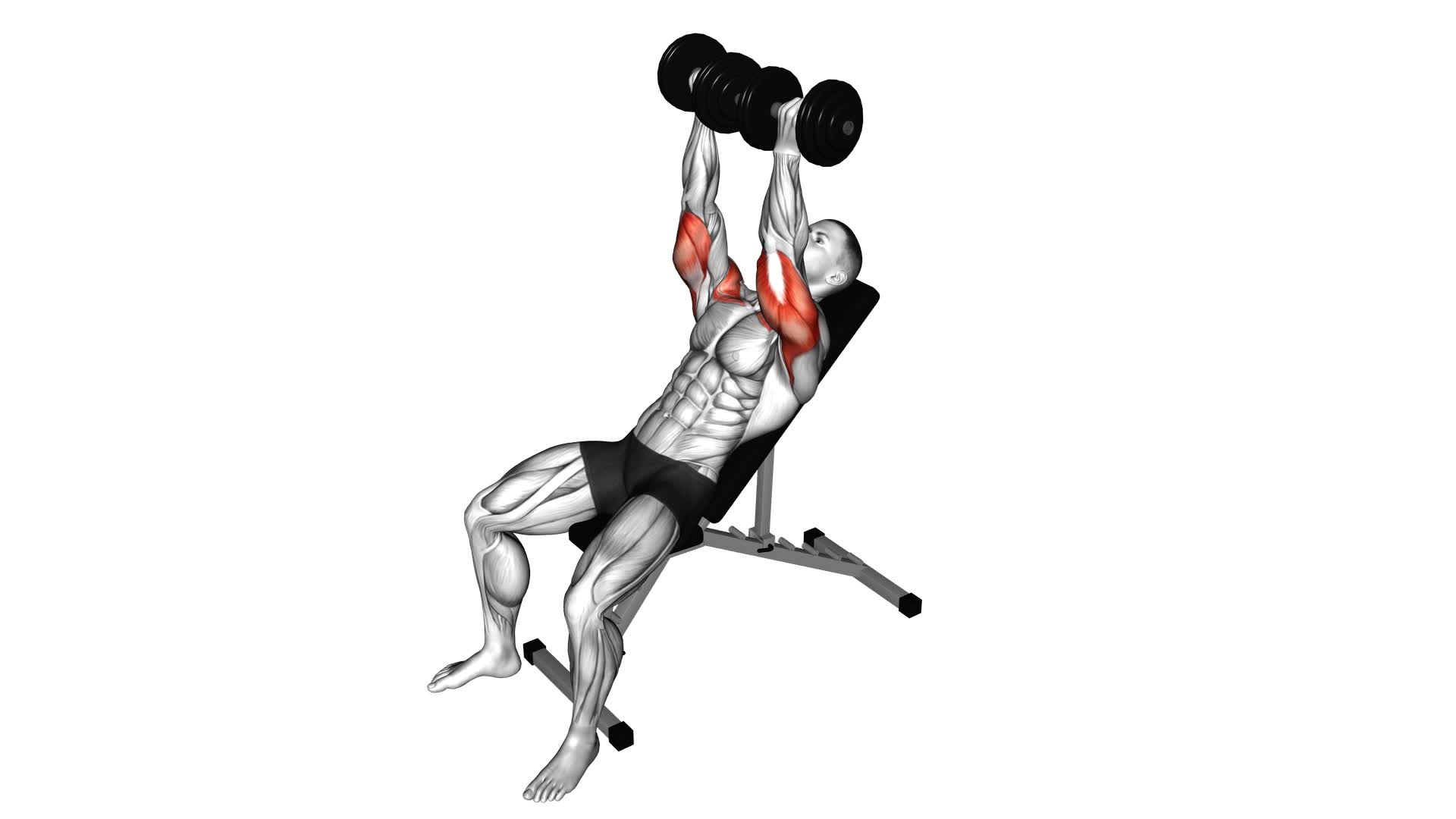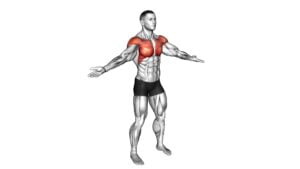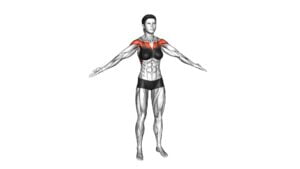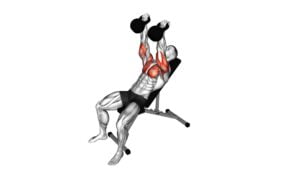Dumbbell Incline Palm-in Press – Video Exercise Guide & Tips

Get ready to take your upper body workout to the next level with the dumbbell incline palm-in press. This exercise targets your chest, shoulders, and triceps, helping you build strength and definition.
Watch This Exercise Video
In this video exercise guide, we'll show you the proper technique and provide helpful tips to maximize your results. Whether you're a beginner or a seasoned fitness enthusiast, the dumbbell incline palm-in press is a must-try exercise.
Let's get started and get those muscles working!
Key Takeaways
- The Dumbbell Incline Palm-in Press targets the chest, shoulders, and triceps.
- It builds strength and definition in the upper body.
- Variations can be used to increase the challenge of the exercise.
- Proper form and technique, such as maintaining a stable shoulder position and using a neutral grip, are important for a safe and effective workout.
Benefits of the Dumbbell Incline Palm-in Press
You can experience enhanced upper body strength and stability with the Dumbbell Incline Palm-in Press. This exercise targets several muscle groups, including the chest, shoulders, and triceps. The Dumbbell Incline Palm-in Press offers various variations to challenge and engage these muscle groups even further.
One variation involves using a neutral grip, where the palms face each other throughout the movement. This variation places more emphasis on the inner chest and triceps. Another variation is to perform the exercise with one arm at a time, which helps improve unilateral strength and stability. Additionally, you can increase the intensity by using heavier dumbbells or adjusting the incline angle of the bench.
By incorporating these variations into your workout routine, you can effectively target different areas of your upper body and promote overall strength and stability.
Now that you understand the benefits of the Dumbbell Incline Palm-in Press, let's move on to the proper equipment and setup for this exercise.
Proper Equipment and Setup
To properly set up for the Dumbbell Incline Palm-in Press, you'll need the right equipment and a suitable bench angle. Here are four key elements to consider for the equipment and setup:
- Dumbbells: Choose dumbbells that are appropriate for your strength and fitness level. Start with a weight that challenges you but still allows for proper form and control.
- Incline Bench: Use an incline bench set at an angle of around 45 degrees. This angle targets the upper chest muscles more effectively, providing a greater range of motion.
- Grip: Hold the dumbbells with a neutral grip, with your palms facing each other. This hand position helps to engage the chest muscles and reduces strain on the wrists.
- Shoulder Position: Maintain a stable shoulder position throughout the exercise. Keep your shoulders back and down, avoiding any hunching or shrugging.
With the proper dumbbell incline palm in press equipment and setup, you can ensure a safe and effective workout. Now, let's move on to the step-by-step guide for performing the exercise.
Step-by-Step Guide for Performing the Exercise
To perform the Dumbbell Incline Palm-in Press exercise correctly, focus on your body positioning. Start by adjusting the incline bench to a 45-degree angle. Sit down on the bench and firmly plant your feet on the ground. Hold a dumbbell in each hand with your palms facing inward and lift them up to shoulder level. This is your starting position.
Next, exhale and push the dumbbells up in a smooth and controlled motion. Make sure to keep your wrists straight and avoid locking your elbows at the top of the movement. Inhale as you slowly lower the dumbbells back to the starting position, maintaining control throughout the entire exercise.
Proper form techniques include keeping your back flat against the bench and engaging your core for stability. It's important to maintain a steady and controlled pace, focusing on the muscles you're targeting. Avoid using momentum or arching your back to lift the weights.
Common mistakes to watch out for include using too much weight, which can lead to improper form and potential injury. Also, avoid shrugging your shoulders or allowing your elbows to flare out during the exercise.
Common Mistakes to Avoid
One common mistake to avoid during the Dumbbell Incline Palm-in Press is using too much weight. While it may be tempting to challenge yourself with heavier dumbbells, using weights that are too heavy can compromise your form and increase the risk of injury.
To ensure you're performing the exercise correctly and safely, here are some common mistakes to avoid and proper form techniques to follow:
- Arching your back: It's important to maintain proper spinal alignment throughout the exercise. Avoid arching your back or lifting your hips off the bench. Engage your core and keep your back flat against the bench.
- Flaring your elbows: Keep your elbows slightly tucked in and close to your body. Avoid letting them flare out to the sides, as this can strain your shoulders and compromise the effectiveness of the exercise.
- Rushing the movement: Take your time with each repetition, focusing on proper form and control. Avoid rushing through the exercise, as this can lead to jerky movements and decreased muscle engagement.
- Neglecting your breathing: Remember to breathe throughout the exercise. Inhale as you lower the dumbbells and exhale as you press them back up. Proper breathing techniques help stabilize your core and enhance your overall performance.
Variations and Modifications for Different Fitness Levels
Try modifying the Dumbbell Incline Palm-in Press by adjusting the bench angle to challenge different muscle groups. By changing the angle of the bench, you can target specific areas of your chest and shoulders. For example, if you lower the bench angle, you'll engage more of your upper chest muscles. Conversely, if you increase the bench angle, you'll activate your front deltoids more.
Another way to modify this exercise is by using different grips. By using a neutral grip (palms facing each other), you'll target your triceps and inner chest muscles more. On the other hand, using a pronated grip (palms facing forward) will engage your anterior deltoids and outer chest muscles.
Remember, the key to maximizing muscle activation is to maintain proper form and control throughout the movement. Focus on squeezing your chest and shoulders at the top of the press and slowly lowering the dumbbells back down.
Now that you know how to modify the Dumbbell Incline Palm-in Press, let's move on to the next section where we'll discuss tips for getting the most out of your dumbbell incline palm-in press.
Tips for Getting the Most Out of Your Dumbbell Incline Palm-In Press
To get the most out of your dumbbell incline palm-in press, it's important to focus on proper form techniques.
Keep your back flat against the bench and engage your core muscles to maintain stability.
Additionally, vary the weight and repetitions to challenge your muscles and maximize the benefits of this exercise.
Proper Form Techniques
To maximize the effectiveness of your dumbbell incline palm-in press, ensure that you maintain a stable and controlled motion throughout the exercise. Here are some proper form techniques to help you get the most out of this exercise:
- Keep your back flat against the bench: This will help engage your chest muscles and prevent any strain on your lower back.
- Maintain a slight bend in your elbows: Avoid locking your elbows at the top of the movement to keep tension on your chest muscles.
- Focus on squeezing your chest: As you press the dumbbells up, imagine squeezing your chest muscles together to fully engage them.
- Control the descent: Slowly lower the dumbbells back to starting position, keeping tension on your chest muscles throughout the entire range of motion.
Benefits and Variations
To optimize the benefits of your dumbbell incline palm-in press and explore variations, focus on maximizing the engagement of your chest muscles.
One way to do this is by using different grips during the exercise. By using a neutral grip, where your palms face each other, you can target the inner part of your chest more effectively. On the other hand, using a pronated grip, where your palms face away from you, will engage the outer part of your chest.
By alternating between these two grips, you can ensure balanced muscle activation and achieve overall chest development.
Additionally, incorporating slow and controlled movements throughout the exercise will further enhance muscle activation and promote muscle growth.
Remember to always maintain proper form and consult with a fitness professional for personalized guidance.
Frequently Asked Questions
How Many Repetitions and Sets Should I Do for the Dumbbell Incline Palm-In Press?
For the dumbbell incline palm-in press, you should aim for 3-4 sets of 8-12 repetitions.
This exercise is great for targeting your chest muscles and building upper body strength.
By incorporating it into your workout routine, you can improve your bench press and enhance your overall upper body development.
To add variation, you can try adjusting the incline angle or using different weights.
Remember to maintain proper form and gradually increase the resistance as you get stronger.
Is the Dumbbell Incline Palm-In Press Suitable for Beginners?
Yes, the dumbbell incline palm-in press is suitable for beginners. It offers several benefits for beginners, such as targeting the chest, shoulders, and triceps muscles. This exercise helps improve upper body strength and stability.
For beginners, it's important to start with lighter weights and gradually increase as you build strength. If you find it challenging, you can modify the exercise by using a resistance band or performing the exercise on a flat bench instead of an incline bench.
Can I Perform the Dumbbell Incline Palm-In Press With a Barbell Instead of Dumbbells?
Yes, you can perform the dumbbell incline palm-in press with a barbell instead of dumbbells. Using a barbell allows you to lift heavier weights and engage more muscles, making it a great choice for building strength.
However, it may be slightly more challenging to maintain proper form and grip with a barbell compared to dumbbells.
It's also worth exploring different grips with the dumbbell incline press to target different muscle groups and add variety to your workouts.
Is It Necessary to Warm up Before Doing the Dumbbell Incline Palm-In Press?
Before you start the dumbbell incline palm-in press, it's important to warm up your muscles to prevent injury and maximize performance. Skipping the warm-up can lead to muscle strains and decreased range of motion.
Take a few minutes to do some dynamic stretches and light cardio to increase blood flow and flexibility. This will prepare your body for the exercise and help you achieve better results.
What Muscles Does the Dumbbell Incline Palm-In Press Primarily Target?
The dumbbell incline palm-in press primarily targets your chest muscles, specifically the pectoralis major. This exercise is great for building upper body strength and muscle definition. By using dumbbells, you engage more stabilizer muscles compared to using a barbell.
Additionally, the palm-in grip variation places more emphasis on the inner chest muscles. Incorporating this exercise into your routine can help you achieve a well-rounded chest workout and reap its benefits.
Conclusion
In conclusion, the dumbbell incline palm-in press is an effective exercise that targets the chest muscles. By using proper equipment and following the step-by-step guide, you can perform this exercise correctly and avoid common mistakes.
Additionally, there are variations and modifications available for different fitness levels. Remember to follow the tips provided to get the most out of your dumbbell incline palm-in press and achieve your fitness goals.

Author
Years ago, the spark of my life’s passion ignited in my mind the moment I stepped into the local gym for the first time. The inaugural bead of perspiration, the initial endeavor, the very first surge of endorphins, and a sense of pride that washed over me post-workout marked the beginning of my deep-seated interest in strength sports, fitness, and sports nutrition. This very curiosity blossomed rapidly into a profound fascination, propelling me to earn a Master’s degree in Physical Education from the Academy of Physical Education in Krakow, followed by a Sports Manager diploma from the Jagiellonian University. My journey of growth led me to gain more specialized qualifications, such as being a certified personal trainer with a focus on sports dietetics, a lifeguard, and an instructor for wellness and corrective gymnastics. Theoretical knowledge paired seamlessly with practical experience, reinforcing my belief that the transformation of individuals under my guidance was also a reflection of my personal growth. This belief holds true even today. Each day, I strive to push the boundaries and explore new realms. These realms gently elevate me to greater heights. The unique combination of passion for my field and the continuous quest for growth fuels my drive to break new ground.







